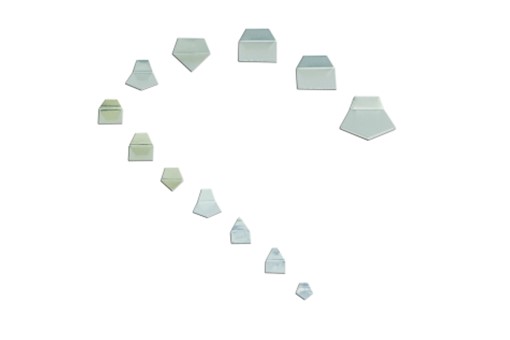The Ministry of Digital Development assessed the shortage of coated paper for books due to EU sanctions
The shortage of coated paper used to print high-quality books due to EU sanctions will amount to 40% of the volume consumed in Russia. RBC presented such an assessment to the Ministry of Digital Development (the ministry did not specify on the basis of what data these calculations were made). Under the current conditions, as stated in the department, the book industry will have to use domestic grades of offset paper or replace the deficit by reorienting to imports from other regions, primarily from CHINA .
The European Union has introduced the fifth package of sanctions. What is important to know Business
Coated paper and offset paper are two of the most popular materials for book printing. Coated is traditionally used for the most expensive and high-quality publications with illustrations that require high color reproduction, as well as newspaper and magazine products and advertising. About a third of the books produced in Russia fall on such paper, Tatyana Ivanova, member of the board of the Union of Printing Industry Enterprises (GIPP), estimates. Imports of such grades of paper in 2020, according to the Federal Customs Service (latest available data for the full year), amounted to 636 thousand tons for a total of $601 million. According to Ivanova, this is 80-85% of the market volume. In turn, almost 71% of these deliveries were provided by European countries. The GIPP has not yet made calculations for 2021, but, as noted in the association, the ratio has remained approximately the same.
The main supplier of coated paper to Russia from the EU countries is traditionally Finland, which accounts for almost 42% of all imports. it is followed by Germany (10%) and Sweden (8%). The share of China, which the Ministry of Digital Development is now proposing to refocus on, was about 16% at the end of 2020.
There are only two Russian manufacturers of coated paper on the market - Kama and Ilim. These enterprises, according to Ivanova, in total occupy only 15–20% of the segment of the coated paper market, which is also necessary for book printing. Ilim, according to its own estimates, supplies the domestic market with about 60 thousand tons of pure cellulose coated paper "Omela". RBC sent a request to the press service of Ilim.
The Ministry of Industry and Trade announced the timing of the stabilization of the supply of office paper Business
Not only raw materials for typography
The EU sanctions list also included significant materials for the production of packaging and trade in book products, draws the attention of Olga Shirokova, CEO of the analytical company SBO (former Union of Paper Wholesalers). These are all coated cardboards, kraft cardboards, label papers and thermal paper, and partially films for flexible packaging, Shirokova lists. According to her, the share of imports from the EU in these categories ranged from 50 to 100%.
Pro The company has suspended business in Russia. What to prepare for its DIRECTOR Articles Pro Sberbank, VTB and Tinkoff:Less high-quality offset paper is in great demand among book publishers. In total, its production, as specified by RBC in the Ministry of Industry and Trade, is 890 thousand tons per year. If necessary, manufacturers are ready to increase volumes by re-equipping and diversifying other enterprises, the ministry added, without specifying details. The Mintsifra only stated that offset paper is produced in Russia in “sufficient quantities”.
Publishers had to abandon books that mention banned social networks Technology and media
What Publishers Say
The Eksmo-AST publishing group (included, according to the Russian Book Chamber, in the top 3 publishers that released the largest total circulation of non-periodicals in 2021 with an indicator of 77 million copies) published approximately 15% of the range on imported paper, its president told RBC Oleg Novikov. Rosmen (total circulation in 2021 - 9.2 million copies), according to the director of the publishing house Boris Kuznetsov, published about a quarter of the books on imported materials. At Alpina (1.2 million copies), according to the production director of the publishing group Konstantin Lun, this figure was 20%. The representative of "Ripol Classic" (990 thousand copies), in turn, noted that in their assortment there are no books that are 100% made only from Russian materials.
The press service of Enlightenment, the country's largest publisher of educational literature (over 131 million copies), did not respond to RBC's request at the time of publication.
"Enlightenment" will enter the recognition of the DPR and LPR in textbooks Technology and media
Increasing imports of coated paper from China will "more than double" the price of paper in DOLLAR terms due to both more difficult logistics and a higher selling price, Kuznetsov warns. According to him, in the current conditions, his company has already been forced to abandon some of the publications. Kuznetsov did not specify which books in question.
Alpina, in turn, after the depletion of Finnish paper stocks plans to completely switch to Russian. At the same time, the publishing house admits that there are no options similar to imported ones now. Finnish paper, Lun explains, gives some editions additional, albeit optional, qualities: it has a specific, slightly rough surface finish and an ivory-tinted color. It is usually used for publications on history, psychology and fiction.
Domestic coated paper, according to GIPP President Alexei Ivanov, has already increased in price by 34% in March compared to the figures at the beginning of the year: up to 110 thousand rubles. per ton. Against this background, and also because of the rise in the price of printing services, the Ministry of Digital Development already admits an increase in the cost of books. Most of the materials and components for the printing industry are imported and subject to exchange rate fluctuations and logistics costs, a spokesman for the ministry said.
Ulitskaya and Vodolazkin asked the government to support book publishers Business
The cost of book production has increased by more than 50% since the end of February 2022, Rosmen notes. For some positions, the growth was more than 100%. Coated paper, self-adhesive film and quality cardboard have almost disappeared from the market. “Partially offsetting the increase in costs, we, for our part, raised the price of books by only 12-15%, but in the future we will revise prices,” explains Kuznetsov.
Novikov gives a different estimate: the increase in the cost of book production, according to him, over the same period amounted to approximately 30%. At the same time, the publisher strives not to raise prices by more than 20%, monitoring the sensitivity of demand to price. Ripol Classic, in turn, does not rule out a 15-30% increase in the final price of its books.
How have books risen in price over the past five years?
According to the Eksmo publishing house , since 2017, selling prices have increased by almost 49%: from 150 to 224 rubles. In 2021, the cost of books increased by 30% due to higher prices by paper and cardboard manufacturers, as well as the resulting shortage of printing capacity.
In the united retail network "Chitay-gorod - Bukvoed" growth over the past five years has amounted to about 30%: from 330 to 440 rubles. In the Moscow House of Books, the average price of a book sold in 2017 was 390 rubles, in 2020 - 480 rubles. In 2021, the indicator increased by another 12% compared to the previous year, reaching 540 rubles. According to the results of the first month and a half of 2022, it was already 610 rubles.
Read together with it:
- The Russian Ministry of Agriculture proposes extending veterinary regulations until 2032.The extension includes regulations for the prevention and eradication of diseases such as bradsot (Clostridium septicum), trichinosis (Trichinella), blackleg (Clostridium chauvoei), and porcine reproductive and respiratory syndrome (PRRS). The proposed changes stipulate the following new deadlines: for bradsot and trichinosis - from March 1, 2......
- UniCredit заявил о галактических усилиях из-за санкций против РоссииUniCredit старается не нарушить «более 15 тыс. санкций», а также не «совершать ошибки», которые позволят изъять его активы в России, заявил гендиректор. После начала военной операции банк начал рассматривать возможность ухода Итальянский банк UniCredit прилагает «галактические усилия», пытаясь соблюсти международные санкции в отношении своего российского подразделения. Об этом заявил генеральный д...
- "Коллективы АПК способны решать любые задачи даже в непростых условиях". Назаров о заслугах сельхозпроизводителейЮрий Назаров 13 ноября, Минск. Обеспечение продовольственной безопасности страны - большое достижение трудовых коллективов аграриев, отметил управляющий делами Президента Республики Беларусь Юрий Назаров на торжественной церемонии награждения государственными и иными наградами работников АПК Управления делами Президента Республики Беларусь, передает корреспондент БЕЛТА. Торжественная церемония наг...
- He crawled to the icon with prayer. The true story of a man who overcame drug addiction.Alexander Ovchinnikov. Topic News. Our project's hero was a drug addict for many years. The thought that this was a dead end never left him, but his addiction proved stronger. One day, when he could no longer walk, he crawled to an icon in prayer. This became his first step toward a new life. Today, he heads a charity center that helps those who have given up hope and are unable to quit ALCOHOL an...
- Низкое предложение и устойчивый спрос: в Аргентине растут цены на мясоЦены на говядину снова выросли, что отразилось на полках супермаркетов и в мясных магазинах. За последние две недели розничные цены выросли на 8–12%, а на некоторые популярные отрубы рост превысил 15% по сравнению с октябрем. Тем не менее, продажи остаются высокими: потребители продолжают покупать, принимая новые цены и закрепляя тенденцию, которая повторяется каждый год в конце года, когда спрос ...
- Колумбия: При экспорте скота сертификация и прослеживаемость больше не являются необязательнымиВысококачественное животноводство, особенно при экспорте, требует сертификации и прослеживаемости. Это необходимые условия для выхода и конкуренции на многих международных рынках, а также на некоторых всё более требовательных внутренних рынках. Колумбийское животноводство не является исключением из этих правил, и, хотя предстоит ещё многое сделать, всё большее число ферм и компаний внедряют эти ме...





























































